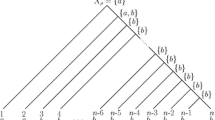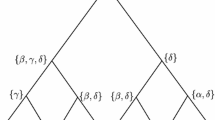Abstract
In this paper, we investigate a conjecture by Arndt von Haeseler concerning the Maximum Parsimony method for phylogenetic estimation, which was published by the Newton Institute in Cambridge on a list of open phylogenetic problems in 2007. This conjecture deals with the question whether Maximum Parsimony trees are hereditary. The conjecture suggests that a Maximum Parsimony tree for a particular (DNA) alignment necessarily has subtrees of all possible sizes which are most parsimonious for the corresponding subalignments. We answer the conjecture affirmatively for binary alignments on 5 taxa but also show how to construct examples for which Maximum Parsimony trees are not hereditary. Apart from showing that a most parsimonious tree cannot generally be reduced to a most parsimonious tree on fewer taxa, we also show that compatible most parsimonious quartets do not have to provide a most parsimonious supertree. Last, we show that our results can be generalized to Maximum Likelihood for certain nucleotide substitution models.
Similar content being viewed by others
References
Bandelt HJ, Dress A (1986) Reconstructing the shape of a tree from observed dissimilarity data. Adv Appl Math 7: 309–343
Chor B, Tuller T (2006) Finding a maximum likelihood tree is hard. J ACM 53: 722–744
Felsenstein J (1978) Cases in which parsimony or compatibility will be positively misleading. Syst Zool 27: 401–410
Felsenstein J (2004) Inferring phylogenies. Sinauer Associates, Massachusetts
Felsenstein J (2005) Phylip (phylogeny inference package version 3.6. Distributed by the author, Department of Genome Sciences. University of Washington, Seattle
Felsenstein J, Archie J, Day W, Maddison W, Meacham C, Rohlf F, Swofford D (2000) The newick tree format. http://evolution.genetics.washington.edu/phylip/newicktree.html
Fitch W (1971) Toward defining the course of evolution: minimum change for a specific tree topology. Syst Zool 20(4): 406–416
Foulds L, Graham R (1982) The steiner problem in phylogeny is np-complete. Adv Appl Math 3: 43–49
Jukes T, Cantor C (1969) Evolution of protein molecules. In: Mammalian Protein Metabolism. Academic Press, New York, pp 21–132
Neyman J (1971) Molecular studies of evolution: A source of novel statistical problems. In:Statistical Decision Theory and Related Topics. Academic Press, New York, pp 1–27
Roch S (2006) A short proof that phylogenetic tree reconstruction by maximum likelihood is hard. IEEE/ACM Trans Comp Biol Bioinform 3: 92–94
Semple C, Steel, M (2003) Phylogenetics. Oxford University Press
Tuffley C, Steel M (1997) Links between maximum likelihood and maximum parsimony under a simple model of site substitution. Bull Math Biol 59: 581–607
von Haeseler A (2007) Hereditary maximum parsimony trees. In: Steel M (ed) Phylogenetics: challenges and conjectures, Isaac Newton Institute for Mathematical Sciences. http://www.newton.ac.uk/programmes/PLG/conj.pdf
von Haeseler A (2009) Hereditary maximum parsimony trees. In: Steel M (ed) Penny Ante List of open problems in phylogenetics, Biomathematics Research Centre of the Allan Wilson Centre for Molecular Ecology and Evolution. http://www.math.canterbury.ac.nz/bio/events/kaikoura09/penny.shtml
Yang Z (2006) Computational Molecular Evolution. Oxford University Press, Oxford
Author information
Authors and Affiliations
Corresponding author
Rights and permissions
About this article
Cite this article
Fischer, M. Non-hereditary Maximum Parsimony trees. J. Math. Biol. 65, 293–308 (2012). https://doi.org/10.1007/s00285-011-0458-9
Received:
Revised:
Published:
Issue Date:
DOI: https://doi.org/10.1007/s00285-011-0458-9




